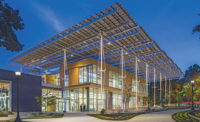Zero-Carbon Standard To Ease the Way to 'Living Buildings'
International Living Future Institute launches simpler certification program

The world's most rigorous sustainable-building certification program has added Carbon-Zero Certification, which recognizes buildings that offset energy use regardless of the location of the renewable energy production. The older three more-formidable building performance programs are Net-Zero Certification, Petal Certification and Living Building Challenge Certification, which is the most difficult.
Copyright International Living Future Institute
By launching the world's first zero-carbon-energy building certification program, the International Living Future Institute, creator of the super-rigorous Living Building Challenge, is further acknowledging that building teams may need to jog before they enter sustainable-building marathons.
ILFI's third-party Zero Carbon Certification initiative, which involves highly efficient buildings that offset energy use regardless of the location of the renewable energy production, is considered an "on-ramp" to the three other more-difficult-to-achieve parts of the LBC. It is also a recognition that the LBC programs do not easily work for new or existing city buildings.
"We have been hearing from members of the Living Future movement that it would be helpful to have a program that is not as aggressive as Zero Energy Certification but more aggressive" than the U.S. Green Building Council's highest rating of LEED Platinum, said Brad Liljequist, ILFI's zero energy director, at the Living Future 2018 conference, May 2-4, in Portland, Ore. "We felt the time was right to simplify but make a hierarchy of quality" in the programs, he added.
Validation Structure
Corporate leaders, including Starbucks and high-technology companies, are purchasing substantial blocks of renewable energy, while, at the same time, they are making substantial improvements in building energy use, Liljequist said at the conference, which attracted 1,200 registrants. The zero carbon standard, introduced last month, is "a validation structure for those efforts and part of getting to a fossil-free future," he added.
ILFI's zero-carbon building operations standard requires that 100% of the project's operational energy use is offset on an annual basis by on-site or off-site renewable energy. This represents a departure. Zero Energy Certification requires net-zero annual energy use with 100% of the energy load offset with on-site renewables.
"I'm really pleased that the institute has recognized that not all renewable power can be generated on site, especially in dense urban areas, and that our future relies on grid-scale renewable energy," said Michael Deane, chief sustainability officer for Turner Construction.
The other two ILFI programs are Petal Certification and LBC Certification. Petal Certification involves meeting at least three of the seven LBC performance areas: materials, site, water, energy, health, equity and beauty. One of the three must be net-zero energy, net-zero water or the use of toxin-free materials, if at all possible. LBC certification is the full certification, including all seven performance areas.
To date, the 11-year-old LBC program has 452 projects around the world pursuing full or partial certification, up from 330 in 2016. The 95 certifications include 21 "Living Buildings," 27 Petal certifications and 47 Zero Energy certifications, said Amanda Sturgeon, ILFI's executive director.
The Zero Carbon Certification program builds on and implements the zero-carbon concept released by Architecture 2030, the Rocky Mountain Institute and the New Buildings Institute. It also is a reaction to the call for zero-carbon standards from the World Green Building Council, issued last year, according to ILFI.
Performance Period
During a one-year performance period, buildings must achieve a targeted energy efficiency level. Existing projects may use any type of energy, including those that are combustion based, but new projects may not use combustion.
ILFI plans to tackle to another performance area: the impact of the construction process on the environment. The aim is to create an embodied-carbon certification program for completed buildings with a plug-in for the carbon involved in construction. "We hope to have that out by the end of the year," said Liljequist.
Turner isn't waiting for another certification program. The construction firm is soon "expected to make a commitment to reduce greenhouse gas emissions from the construction process between now and 2030," said Deane. In its buying practices, Turner plans to give preference to contractors and suppliers that are helping to achieve that goal.
To reduce construction's carbon footprint on a broader scale, Deane added that Turner is in conversations with like-minded construction firms, including DPR Construction, Skanska Construction Corp., Structure Tone and Rand Construction Corp. He sees the Associated General Contractors as a group to help organize a bigger initiative.
"If the construction industry gets together and agrees that's a common goal, we could drive market transformation the way the USGBC did with green buildings," Deane added.





